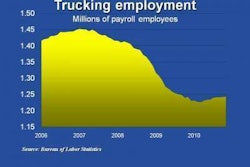Fuel economy rules must be uniform, ATD says
At a hearing in Chicago Nov. 15 on a proposal to establish the first-ever fuel economy rules for commercial and work trucks and engines, the chairman of the American Truck Dealers urged federal regulators to ensure that any new mandates are “appropriate, cost-effective and technologically feasible.” The joint proposal by the U.S. Environmental Protection Agency and the National Highway Traffic Safety Administration establishes three regulatory categories of heavy-duty vehicles: (1) combination tractors; (2) heavy-duty pickup trucks and vans; and (3) vocational vehicles. For combination tractors and vocational vehicles, the agencies have proposed separate engine and vehicle standards. (See “Does Uncle Sam Know Best?” CCJ November 2010.)
Kyle Treadway, ATD chairman, highlighted Section 102 of the Energy Independence and Security Act of 2007, which required that NHTSA determine whether to issue the fuel economy rules. “Congress vested NHTSA with the exclusive authority to regulate the fuel economy of these vehicles and engines,” he said. “This prohibition of any patchwork of state laws related to fuel economy is critical to dealers like me who sell new vehicles in several states, yet is even more important to our customers, such as for-hire carriers, private companies, public fleets and owner-operators who purchase trucks and engines in every state in the nation.”
Treadway said in order for the proposed fuel economy mandates for MYs 2014-2018 to work, they must pass economic muster with truck and engine buyers. “Some of the nation’s largest fleets can afford to be ‘early adopters’ and to experiment with new fuels and technologies, even when they cost significantly more,” he said. “However, the vast majority of prospective new truck buyers … rationally consider the upfront cost of vehicle features, especially during times when credit is relatively tight and/or freight rates and profit margins are relatively low.”
Speaking on behalf of the American Trucking Associations and the Illinois Trucking Association, ITA Associate Director Randy Thomas said the trucking industry is “pleased to see that the rules address four of ATA’s six proactive recommendations for reducing the trucking industry’s carbon footprint contained in its 2008 Sustainability Plan – namely reducing GHGs and improving fuel efficiency by reducing and governing truck speeds; decreasing idling; implementing national fuel efficiency standards for medium- and heavy-duty trucks that are both economically and technologically feasible; and using off-the-shelf technologies to increase fuel efficiency verified by EPA under its GHG reduction program known as SmartWay.”
Thomas said that some fleets, while supportive of the proposed rules, have expressed concern that manufacturers might discontinue sales of specific engine or vehicle subcategories that fleets are accustomed to purchasing, instead of using any of the four “flexibility” approaches outlined in the proposal to assist OEMs in achieving their overall GHG and fuel efficiency targets. “Trucks deemed ‘less efficient’ may no longer be offered for sale to purchasers that spec such equipment for their particular needs,” he said. “The trucking industry supports the proposed rules and, like EPA and NHTSA, wants to ensure the avoidance of ‘unintended consequences’ under the rules.”











